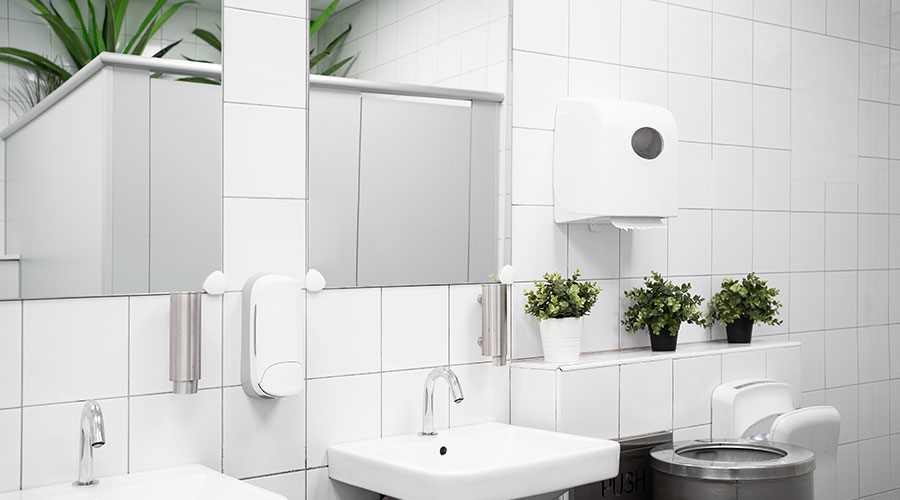Five Minutes With Audio & Video Home
fiveminuteswith
Green-Purchasing Strategies with Tom Badrick
Sustainability Coordinator, Legacy Health System Portland, Ore.
What are some common myths and misconceptions maintenance and engineering managers might have related to green purchasing?
First, managers believe green products and services cost more. Second, managers might think being green won’t help them get approval for projects.
The best advice I can give is, consider life-cycle costs because green products can offer a better payback than their more traditional counterparts. If managers think they can’t justify projects by calling them green, which is a myth, then use the phrase “true life-cycle cost.”
Another piece of advice is don’t be shy. This is important work for the planet and facilities. Also, never underestimate how much this resonates with employees. Share your stories. Share your success. Let people know. If employees tell upper management they want more environmentally responsible products and services, it helps open wallets to pay for more. I don’t know any facilities professionals who say, “You know, we have too much money. Would you reduce our budget, please?”
What role do maintenance and engineering managers play in the purchasing process? How vital is that role in ensuring successful implementation of the green-purchasing plan?
Sometimes, facilities people are not the most openly green. That’s OK, but perhaps that is something they should reconsider. Some of the best advocates for saving energy are facilities professionals. I’d say they have been green much longer than many people because to do their jobs well, they have to focus on energy efficiency and water efficiency. It’s just very good business practice and good engineering.
I don’t work with any facilities people who actively look for opportunities to be wasteful and inefficient. In my role, I’ll take any reason to support the cause of reducing waste, whether it’s because it’s good engineering or because we need to be more sustainable.
In terms of green purchasing, managers can call the shots, so it’s a real opportunity to advocate for the best solution. I don’t know a lot of supply-chain folks who want to argue with engineering managers because the managers better understand the products and their environmental impact on the facility. Also, supply-chain personnel don’t want to advocate against a good solution. So managers have a golden opportunity to advocate for and support green purchasing.
What types of building systems or components should organizations focus on when addressing environmentally responsible purchasing?
I would start with an energy or water audit. Organizations can undergo these audits internally, with a consultant or with a utility. Vendors also can be helpful in this process, although it feels better if an established relationship already exists so it’s not just a sales pitch to boost the commission.
An audit gives organizations tools to systematically move forward with projects large and small. While undergoing larger renovations, audits allow departments to perform smaller maintenance tasks, such as replacing ballasts floor by floor during the remodeling project or specifying emergency lighting with light-emitting diodes on a section-by-section basis. Sink aerators, water filters – to reduce the need for water coolers – and low-flow plumbing fixtures are other examples of common green-purchasing targets.
How can a green-purchasing plan help health care organizations address waste and recycling challenges before packaging-intensive products even enter the facility?
I offend a few people now and then by saying we should focus on recycling last. That’s easy to say, with a 53 percent recycling rate and a top program. But the reality is, preventing waste is a more responsible approach.
A great example is the use of reusable filters versus disposable filters. Even if an organization fully recycles the cardboard and manages the waste as construction and demolition waste, it still produces large volumes of disposables. More importantly, think about how much fuel it takes to deliver the materials and how much labor is involved with the handling of the waste. It is shipped, received, moved to temporary storage, changed out and then disposed of. That’s five steps.
A reusable filter requires some handling, but it skips all the peripheral handling and packaging. Recycling is not free, and putting waste in a cage or compacter is not the end of the line, just the end of the line at a specific facility.
Building components outlined in a green-purchasing plan are designed to be energy efficient, but how can preventive maintenance help ensure those products and systems perform as intended?
The design is only as good as a maintenance plan. There is not much difference between an economy car and a luxury car if the owner doesn’t take care of it, and it’s the same with energy-efficient products. If managers take care of the products, they will last as long as intended. Ignoring maintenance will force managers to fix and replace equipment sooner.
I heard years ago that any purchase order cost a minimum of $150. So managers should try to avoid that cost, whether by spending slightly more for a better product or maintaining equipment so it lasts longer.
Looking at the life-cycle cost is critical. Managers should look beyond the purchase price and consider what the costs will be to maintain and eventually replace the equipment. Managers also should consider the costs related to support services, such as purchasing, receiving, and accounts payable, as well as the cost of packaging. The purchase price is just the starting point. Green purchasing can be the program that helps managers look at the full picture, not just the sticker price.
posted: 7/9/2008









